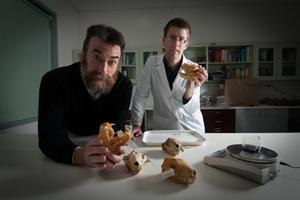
VU researchers Dr Patrick Guay and Dr Randall Robinson are helping to save the Tassie devil.
They are working with partners Zoos Victoria, the Zoo and Aquarium Association, and Save the Tasmanian Devil Foundation to determine whether the brain size of devils bred in captivity decreases over several generations, thereby limiting their survival instincts in the wild.
In recent years the highly infectious and terminal devil facial tumour disease (DFTD) has proved most devastating to their survival. Scientists estimate that 84 per cent of devils have succumbed to DFTD with more currently carrying the disease.
Scientists are now turning to captive breeding to repopulate the species. However, there is concern about the ability of these captive-bred animals to survive once released back into the wild.
Animals bred in captivity with too much human interaction may lose the need to fend for themselves and maintain a wariness of predators.
"It's a case of 'use it or lose it' when it comes to brain size in these animals," Guay says. "They need to keep practicing their hunting and awareness of predators. Otherwise, when we release them in the wild, they won't cope."
In August 2012, the Federal Government gave the green light for a release program to be administered at a national park on Maria Island. If it proves successful, the next step will be to return the devil back to its Tasmanian homeland.
- Download the full PDF article about law pathways at VU
- Download the latest issue of Connections magazine.
You can find out more about the Tassie devil or make a donation to help save this iconic Tasmanian animal.
Did you know?
In 2009 the Tassie devil was declared endangered.
